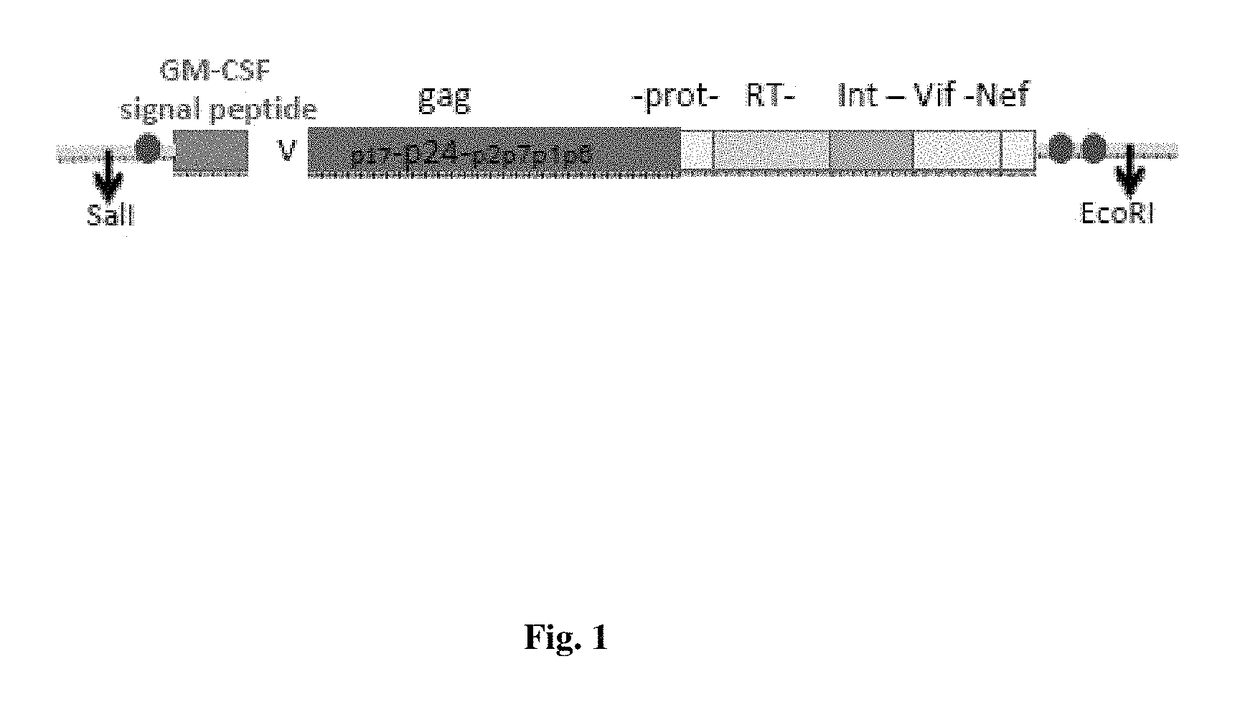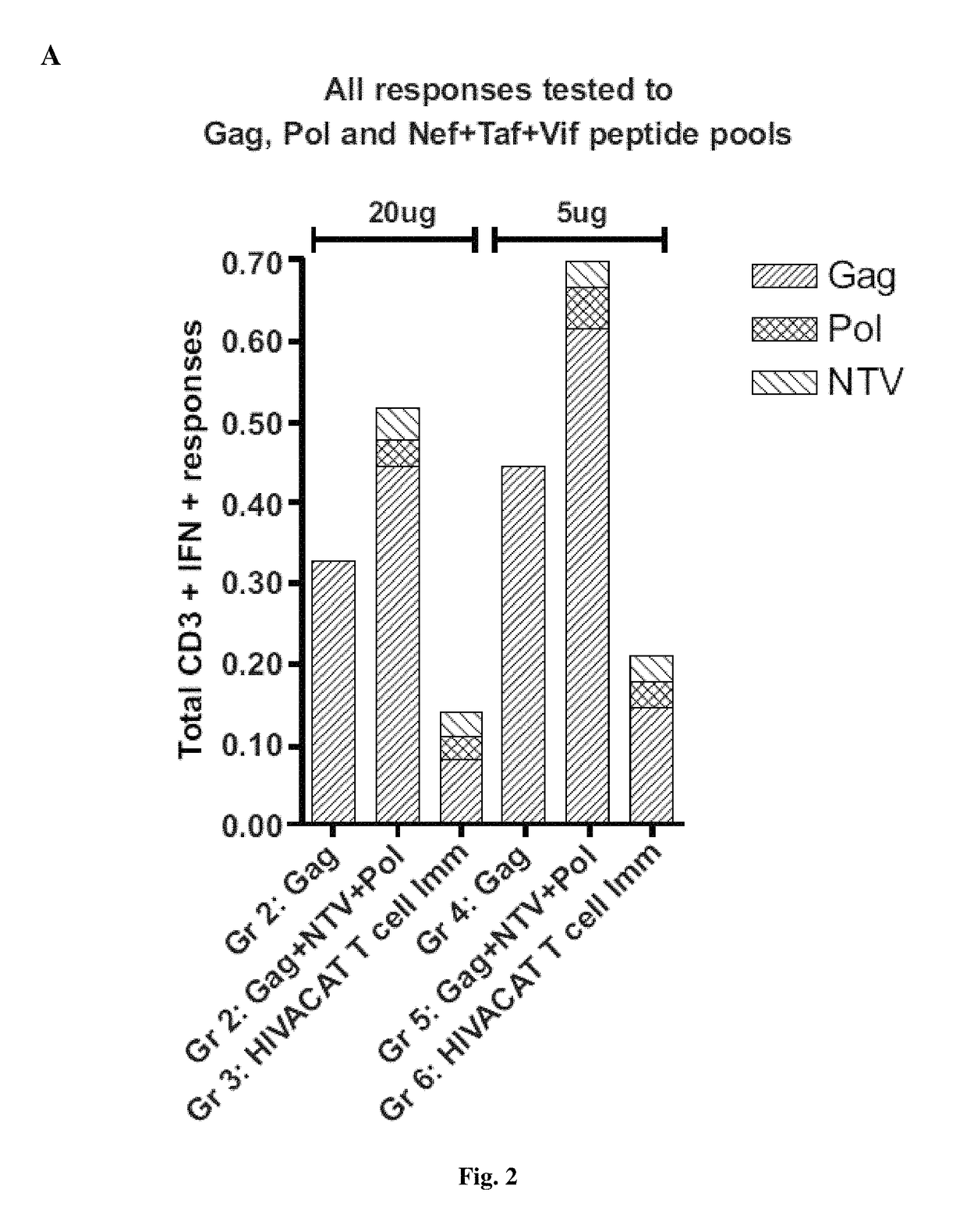Immunogens for HIV vaccination
a technology of immunogens and vaccines, applied in the field of immunogens, can solve the problems of limited ctl escape and viral fitness studies, no analysis assessed the role of responses to shorter regions of targeted protein(s) that may induce particularly effective responses, and the availability of information may not provide relevant information for immunogen sequences
- Summary
- Abstract
- Description
- Claims
- Application Information
AI Technical Summary
Benefits of technology
Problems solved by technology
Method used
Image
Examples
example 1
In-Vitro Expression Studies
[0186]Several transient transfections were performed to assess expression, localization and stability of the HIVACAT T cell immunogen.
[0187]Briefly, 1×106 human 293 cells in complete DMEM plus 10% fetal bovine serum (FBS) were plated on to 60 mm tissue culture dishes and allowed to adhere overnight. HEK 293 cells were transfected by CaPhosphate DNA co-precipitation with a total of 7 μg of DNA (100 ng or 250 ng of the 297H GMCSF-HIVACAT-FLAG plasmid DNA, 50 ng of GFP expressing plasmid pFRED143 topped up to 7 μg with Bluescript DNA).
[0188]6 hours after transfection the medium were replaced with 3 ml of DMEM supplemented with 2% of FCS. After 24 and 48 hrs the cells and the supernatants were collected in 0.5×RIPA.
[0189]Protein expression was analyzed by Western immunoblots. 1 / 250 of the total of the cell extracts and supernatants were loaded. The proteins were resolved by electrophoresis on 10% sodium dodecyl sulfate polyacrylamide gels (Nu-Page Bis-Tris, Nu...
example 2
Cellular Response in Mice
[0195]A stock of 1 ml (2 mg / ml) of 298H GMCSF-HIVACAT DNA was produced endofree for in vivo studies in mice.
[0196]Immunogenicity of the HIVACAT T cell immunogen was evaluated in 6-8 weeks old female C57BL / 6 mice (Charles River Labs, Inc., Frederick, Md., US).
[0197]20 μg and 5 μg of DNA was delivered intramuscularly by electroporation using the Inovio system (Inovio Pharmaceuticals, Inc., Blue Bell, Pa., US) in the left and right quadriceps (20 μg / 50 μl per dose, 25 μl per site) at week 0 and 4. Mice were sacrificed 2 weeks after the last immunization. Mice splenocytes and serum were harvested for immunogenicity studies. Control DNAs used were:[0198]1) 114H p55 gag clade B: expresses full gag protein;[0199]2) 132H NTV: expresses a chimaeric protein of nef, tat and vif;[0200]3) 133H pol: expresses full pol protein; and[0201]4) BV4 CMV-kan-Basic: SHAM control, similar DNA plasmid backbone without any expressed transgene.
[0202]35 mice were used in the experiment...
example 3
Humoral Response in Mice
[0214]Humoral responses were first analyzed in pooled mice sera. Binding antibodies to p24, p37 and p55 were detected by western immunoblot by using cell extracts from HEK 293 cells transfected with the 1 mg of gag expression vectors separated on 12% SDS-Page and probing the membranes with pooled sera from mice (at a 1:100 dilution). Antibody titers to gag p24 were measured by ELISA. Serial 4-fold dilutions of the pooled serum samples were assessed and the optical absorbance at 450 nm was determined (Advanced BioScience Lab, Inc., Kensington, Md., US). The binding titers were reported as the highest dilution scoring positive having a value higher than the average plus 3 standard deviations obtained with control sera from the mice immunized with SHAM DNA.
[0215]a) From the first humoral immunogenicity analyses, the HIVACAT T cell immunogen induced binding antibody responses to gag p55, p37 and p24 detectable by Western blot in the group of mice immunized with 2...
PUM
| Property | Measurement | Unit |
|---|---|---|
| concentration | aaaaa | aaaaa |
| length | aaaaa | aaaaa |
| nucleic acid | aaaaa | aaaaa |
Abstract
Description
Claims
Application Information
 Login to View More
Login to View More - R&D
- Intellectual Property
- Life Sciences
- Materials
- Tech Scout
- Unparalleled Data Quality
- Higher Quality Content
- 60% Fewer Hallucinations
Browse by: Latest US Patents, China's latest patents, Technical Efficacy Thesaurus, Application Domain, Technology Topic, Popular Technical Reports.
© 2025 PatSnap. All rights reserved.Legal|Privacy policy|Modern Slavery Act Transparency Statement|Sitemap|About US| Contact US: help@patsnap.com



